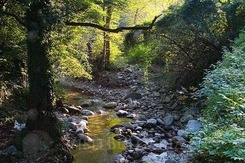Over one billion euro has been invested in the wellness and spa industry in Bulgaria over the past more...
| Search | Hotels / Accommodation | Vacations | Tours & Trips | Rent A Car | Transport | Flights | Conferences | Press Centre | Yachting |
- Hotels & Accommodation in Sofia





- Anel Hotel
- Arena di Serdica
- Grand Hotel Sofia
- Hilton hotel
- Holiday Inn Sofia

- Kempinski - Zografski Hotel
- Radisson Blu Grand hotel
- Sheraton Hotel Balkan




- Best Western Plus Bristol Hotel
- Sofia Princess Hotel
- Anastasia Residence
- Art'Otel hotel
- Berlin Park Vitosha Hotel
- Best Western Europe hotel
- Best Western Hotel Expo
- Best Western Plus City Hotel
- Best Western Premier Thracia
- Casa Boyana Boutique Hotel
- Central Hotel Forum

- Central Park Hotel
- Crystal Palace Hotel
- Festa Hotel Sofia
- Geneva hotel
- Gloria Palace hotel
- Hill Hotel
- Les Fleurs Hotel
- Maria Louisa Hotel
- Maxi Park Hotel & Spa
- Metropolitan Hotel Sofia

- Park Inn Sofia
- Rodina hotel
- Silver House Hotel
- Sofia Residence Boutique Hotel
- Sveta Sofia hotel
- Triada hotel
- Tsarsko Selo hotel
- Vega Hotel
- Vitosha Park Hotel



- Accord Hotel

- Apartment House Dunav
- Aris Hotel
- Arte Hotel
- Atlantic hotel
- Bon Voyage Hotel Alexander
- Budapest Hotel
- Bulgari Boutique Hotel

- City Avenue Hotel
- Elate Plaza Hotel
- Fashion Hotel
- Gorublyansko Hanche
- Hemus Hotel
- Kolikovski Hotel
- Latinka Hotel
- Legends Business Hotel
- Lion hotel

- Lozenetz Hotel
- Maxim Hotel

- Meg-Lozenetz hotel
- Niky hotel
- Park Hotel Moskva
- Renaissance Hotel
- Scotty’s Boutique Hotel
- Slavyanska Beseda hotel
- Sofia Place Hotel
- Vitosha Tulip Hotel


- Arte Apartment House
- ATM Centre Hotel
- Brod hotel
- Eleganza Hotel
- Medik Hotel

- easyHotel Sofia
- Lavele Hostel
- Nearby hotels



- AIR SOFIA GOLF CLUB - IHTIMAN
- Diplomat Holiday Village
- Sofia Guide
- Early booking in Sofia
- All inclusive in Sofia
- Last minute in Sofia
- Hotels in Sofia
- Apartments in Sofia
- Villas in Sofia
- Rural houses in Sofia
- Vacations in Sofia
- Transport To Sofia
- Tours in Sofia
- Conferences in Sofia
- Articles on Sofia
- News From Sofia
- Map of Sofia
- Restaurants in Sofia
- Sofia City Tour
- Rila Monastery
- Dragalevtsi Monastery
- Biking in Vitosha
- Vitosha Mountain
- Dragoman swamp
- Sofia Airport
- Sofia WiFi Zones
- Holidays in Bulgaria
- All inclusive
- Beach
- Birdwatching
- Golf
- Health
- History
- Hunting
- Monasteries/ Religious
- Mountain biking
- Prom
- Rural
- Ski
- Spa & Wellness
- Trekking
- Water sports
- Weekend breaks
- Wine
- Conference
- Children Holidays
- Yachting
- Events
- Type of accommodation
- Hotels
- Apartments
- Villas
- Rural houses
- Destinations
- Aheloy
- Ahtopol
- Albena
- Apriltsi
- Arbanassi
- Asparuhovo
- Assenovgrad
- Bachkovo Monastery
- Balchik
- Bankya
- Bansko
- Banya (Karlovo)
- Banya (Razlog)
- Batak
- Beklemeto
- Belchin Bani
- Beli Iskar
- Belogradchik
- Berkovitsa
- Blagoevgrad
- Bodrost
- Bojichen
- Borovets
- Botevgrad
- Bourgas
- Bozhentsi
- Bratsigovo
- Brestovitsa
- Buzludja
- Byala
- Chepelare
- Cherepish Monastery
- Chernomorets
- Chiflik
- Devin
- Dimitrovgrad
- Dobarsko
- Dobrich
- Dobrinishte
- Dolna Banya
- Dospat
- Dryanovo
- Dupnitsa
- Dyuni
- Elena
- Elenite
- Elhovo
- Gabrovo
- Gela
- Golden Sands
- Gorna Oryahovitsa
- Gotse Delchev
- Govedartsi
- Grand Hotel Varna
- Harmanli
- Haskovo
- Haskovo Mineral Baths
- Hissarya
- Ivaylovgrad
- Kalofer
- Kamchia
- Kamen Bryag
- Kardjali
- Karlovo
- Kavarna
- Kazanlak
- Kiten
- Kom
- Koprivshtitsa
- Kosharitsa
- Kostenets
- Kostenkovtsi
- Kotel
- Kovatchevitsa
- Kranevo
- Kresna
- Kulinoto
- Kyustendil
- Lom
- Lovech
- Lozenets
- Lukovit
- Lyaskovets
- Madara
- Malko Tarnovo
- Malyovitsa
- Melnik
- Mezdra
- Momchilovtsi
- Montana
- Narechen Baths
- Near Golden Sands
- Nessebar
- Obzor
- Ognyanovo
- Osogovo
- Pamporovo
- Panagyurishte
- Panichishte
- Parshevitsa
- Pavel Banya
- Pavlikeni
- Pazardjik
- Pernik
- Petrich
- Pirdop
- Pleven
- Pliska
- Plovdiv
- Pomorie
- Pravets
- Preslav
- Primorsko
- Ravda
- Razgrad
- Razlog
- Ribaritsa
- Rila Monastery
- Riviera
- Rousse
- Rusalka
- Samokov
- Sandanski
- Sapareva Banya
- Semkovo
- Sevlievo
- Shabla
- Shipka
- Shipkovo
- Shiroka Laka
- Shkorpilovtsi
- Shoumen
- Silistra
- Sinemorets
- Sliven
- Smolyan
- Sofia
- Sopot
- Sozopol
- Srebarna
- St. Constantine & Elena
- Stara Zagora
- Starozagorski Baths
- Sunny Beach
- Sunny Day
- Sveti Vlas
- Svilengrad
- Svishtov
- Targovishte
- Teteven
- Tran
- Trigrad
- Troyan
- Tryavna
- Tsarevo
- Tsigov Chark
- Uzana
- Varna
- Varshets
- Veliko Tarnovo
- Velingrad
- Vidin
- Vitosha
- Voneshta Voda
- Vratsa
- Vratsata Gorge
- Yagoda
- Yakoruda
- Yambol
- Zlatitsa
- Zlatograd
- Bulgaria Guide
- General information
- Bulgarian Monasteries
- SPA Bulgaria
- The Black sea
- History
- Geography
- Maps
- Weather
- Airports in Bulgaria
- Webcams
- Forums
- Mountains in Bulgaria
- The Balkan Mountain Range
- Rila Mountain
- Pirin Mountain
- The Rodope Mountain
- Vitosha Mountain
- Travel Arrangements
- Visit Bulgaria
- Visa Requierments
- Choose Destination
- Flights to Bulgaria
- Transport in Bulgaria
- Advice
- Currency
- Official Holidays
Subscribe to newsletters to receive our hottest offers:
| Home > Sofia > News |
The Village of Bussintzi in Western Bulgaria, a Pottery Centre for Centuries
Bnr.bg, Written by Rumyana Panayotova, English version by Radostin Zhelev

The village of Bussintzi lies only 8 km away from the town of Trun, near the border with neighbouring Serbia to the west of Sofia. Its fame is largely due to the centuries’ old tradition of the popular Bussintzi ceramics.
Bussintzi is only a couple of hours drive away from the capital city Sofia. The road meanders among hilly land. Parallel to the road run the wild waters of the tiny Erma River. Magnificent cliffs dominate the landscape cut by the river and shaped into a colorful ravine among the hills.
One more bend in the road, and the village looms before our gaze sprawled over a gentle mountain slope. The first building that arrests our attention is a simple one-storey house. But the long years of its history simply cannot remain unnoticed. It was built at the turn of the 20th century to house the first Bulgarian ceramics school. It has saved to this day the olden ceramic furnaces, but has nevertheless one big modern electricity-driven furnace in one of its workshops. The master potter school of old has become today a small workshop for ceramic souvenirs crafted using the traditional patterns, earthen jugs, bowls, etc.
The traditional potter’s wheel is there for visitors to see.
Pottery has been the main means of existence for the local male population for many centuries. In the village environs there are rich deposits of various types of clay, the mixing of which remained one of the best-kept secrets of the local craftsmen. They were able to make pottery that gave out a peculiar ringing sound when tapped on.
The village has its own Museum of Ceramics, whose curator is Tzvetanka Zaharieva. Says she,
“The colours of autumn, yellow, green and crimson are typical of the ceramics crafted in Bussintzi. In the old days the local craftsmen applied local ores and plants for the dyeing of the ceramics. Every one of them had their own recipes for the hues, the mixing of the clay and the crafting of the pottery. One typical example are the small wine and grape brandy pitchers decorated with small figurines. Those were used for inviting a best man or other guests to weddings and various celebrations.”
The museum collection traces the pottery making tradition to present-day artistic ceramics. The museum premises were built in 1982, and encompass workshops and a small hotel wing. The latter makes it very suitable for hosting national and international open-air seminars on artistic ceramics.
Another local landmark is a one-storey house, whose façade has been richly covered in colourful ceramic plates. The house has been declared part of the cultural heritage. It has an interesting history. It was erected by a potter, who had inherited the family trade, and who enjoyed tremendous popularity, and even got an invitation to present his art at the first Bulgarian industrial and agricultural exposition in Plovdiv way back in 1892. But instead of making simple utilitarian pottery, he mastered a ‘collection’ of clay human figurines. The collection stirred unprecedented interest among the visitors to the exhibition and was bought off for a considerable price. The money lasted him to build the house in question. After him, his three sons became potters in their turn, but it was only the youngest of them, Petar Ghigov, who became world known for his skills. Works by him have become the possession of Le Louvre and Le Musee d’Homme in Paris, British Museum, the World Ceramics Museum in Italy, as well as museum collections in Japan, the United States, Russia, New Zealand, and India. He continued to work right up to his death in 1991. His descendents have decided to establish a school for the learning of the local pottery making traditions. But the beautiful scenery and the calm atmosphere give Bussintzi a chance of becoming a mighty attraction for tourism and recreation.


















